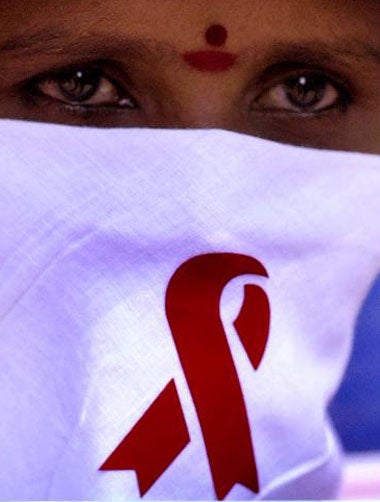'Breakthrough' for scientists hunting Aids cure

A decade after the development of a therapeutic drug cocktail which transformed Aids from a killer infection to a chronic disease, doctors said yesterday that they may have made the next big breakthrough.
Aids is unique among infectious diseases because even after treatment with a cocktail of powerful drugs, "latent" virus remains hidden in the body's DNA and erupts as soon as treatment stops.
The scientists found that combining a cheap drug called valproic acid with the existing therapeutic cocktail, the level of "latent" HIV fell dramatically. They claim they may be able to eliminate the latent HIV altogether, curing the disease.
David Margolis, who led the research team at the University of North Carolina, said: "Our findings suggest that eradication of established HIV infection might be achieved in a staged approach. This finding, though not definitive, suggests that new approaches will allow the cure of HIV in the future.
"I would like to set scientists on the way to looking for a means to eradicate the virus. That is why I am excited about this. But I don't expect it to happen soon. In the meantime prevention has to be the key message."
The US researchers describe their research as a "proof of concept" study which involved testing four patients who had been on long-term treatment with the standard drug cocktail. They say it opens up new research possibilities but it will be many years before a new treatment results.
The claims, published in The Lancet, had some scientists hailing a breakthrough as others warned against talk of a cure. One dismissed the researchers' claims altogether.
Jean Pierre Routy, of McGill University in Canada, said in a Lancet commentary that the finding "merits further urgent study". Speaking to The Independent, he said: "It is a milestone. It paves the way to a possible cure. Last week we thought it was impossible [to eradicate the virus]. Now for the first time this finding shows it could be workable." Robin Weiss, professor of virology and an expert on HIV at University College London said: "This is a potentially exciting advance, but any talk of "curing" infection is premature if not reckless."
The researchers' optimism was challenged by Abraham Karpas, of the University of Cambridge, the first person to isolate the HIV virus in the UK, who said: "It is absolute nonsense. They don't understand the biology of the virus. We will cure every cancer before we find a cure for HIV. The only way to defeat this disease so far is to prevent infection."
HIV has presented science with one of its greatest challenges because of its ability to infiltrate the DNA in the cell, the genetic code, from which new virus can be generated.
Active virus is destroyed by the drug cocktail known as highly active antiretroviral therapy (Haart), now the standard treatment for HIV. But the latent virus remains hidden and scientists have believed that it was impossible selectively to kill the infected cells or to flush out the virus hidden in them.
The University of North Carolina team intensified the effect of Haart with an extra drug and then gave the patients valproic acid, used to treat epilepsy since the 1960s, twice a day for three months. In three of the patients there was a 75 per cent reduction in latent HIV infection and a smaller reduction in the fourth patient.
Valproic acid is a gene regulator whose mechanism of action is unclear.
Advances come too late for sub-Saharan Africa
In Kwazulu Natal, the South Africanprovince where almost 40 per cent of the adult population are infected with HIV, Nokulunga reaches an emaciated arm from under a blanket to grasp a water bottle by her bed. Ting, her five-year-old daughter, goes to her mother and removes the cap. She is already a carer and soon will join the ranks of Africa's orphans.
Nokulunga, 27, has Aids. Antiretroviral drugs have arrived too late to save her, leaving Ting to an uncertain future. In South Africa half a million children have already been orphaned and the number is expected to treble by 2010.
Scientific advances of the kind reported in today's Lancet have little relevance to sub-Saharan Africa, where more than 25 million people are infected with HIV. The World Health Organisation's target of having three million people on antiretroviral treatment by the end of 2005 is still more than one million short.
The world has put its faith in antiretroviral (ARV) drugs to save Africa from devastation. Cheaper, generic ARV drugs that have appeared on the market recently are helping countries get treatment plans under way.
However, drug treatment, no matter how extensive, will not curb the epidemic. Prevention remains critical. The most effective measures are giving people access to condoms, voluntary HIV testing, treatment for sexually transmitted disease and drugs to prevent mother-to-child transmission.
Public awareness campaigns and prevention programmes have resulted in falling infection rates in some African countries, such as Uganda. And, as more leaders speak out as Nelson Mandela did with his admission that his son died of Aids, stigma and discrimination are lifting.
While HIV has been transformed from a death sentence to a chronic condition manageable with drugs in the West, the same treatments have been denied to people in Africa and elsewhere.
While the West celebrates the latest advance against the virus, the best that Ting's peers can hope for is that by being constantly careful they can avoid lethal infection.
Join our commenting forum
Join thought-provoking conversations, follow other Independent readers and see their replies
Comments
Bookmark popover
Removed from bookmarks